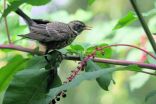(Press-News.org) The immune-boosting properties of breast milk have long been known. Now a team of scientists led by Johns Hopkins pediatric surgeon-in-chief David Hackam, M.D., Ph.D., says experiments in mice reveal how breast milk works to ward off the development of necrotizing enterocolitis (NEC), a devastating intestinal disorder that affects 12 percent of premature babies and claims the lives of one in four of those who have it.
If affirmed in human studies, the experiments could pave the way to new preventive approaches to stave off NEC in premature babies and spark the development of treatments for those who develop the condition.
Findings of the research, published April 22 in the journal Mucosal Immunology, reveal that a substance found in animal and human breast milk called epidermal growth factor, or EGF, blocks the activation of a protein responsible for unlocking the damaging immune cascade that culminates in NEC, a disease marked by the swift and irreversible death of intestinal tissue that remains one of the most-challenging-to-treat conditions.
"We have known for some time that breast milk can protect premature babies against intestinal damage but how and why it did so has been somewhat of a mystery," says Hackam who initiated the study at the University of Pittsburgh and completed it at the Johns Hopkins Children's Center. "We believe that our findings solve a major piece of the mystery of this disorder."
New therapies are acutely needed for NEC, the research team says, because current treatment is limited to surgical removal of the dying, or necrotizing, portions of a baby's intestine. The approach halts further necrosis and can save a baby's life, but it often leaves infants with insufficient intestine and puts them at risk for long-term complications, such as short bowel syndrome, which requires feeding support for life due to the intestines' decreased ability to absorb enough nutrients. Pinpointing EGF as a key factor in NEC should offer new therapeutic targets that obviate or reduce the need for drastic surgery, the researchers say.
Results of the new study build on previous findings by Hackam's team showing that a protein called TLR4 (toll-like receptor 4) is a key instigator of the intestinal damage seen in NEC. Under normal conditions, TLR4 regulates the body's immune response to bacteria, but in the premature gut it plays a slightly different role -- regulating cell differentiation and intestinal growth. Shortly after birth, all babies' intestines become colonized with bacteria, a normal process of adapting to their new living environment. However, in the guts of premature babies, the immature TLR4 protein goes haywire, turning off oxygen supply to the intestines and causing the hallmark cell death of NEC.
In the current study, investigators first exposed immature gut cells to bacteria known to activate the destructive, NEC-inducing TLR4 protein. The expression of TLR4 was notably turned down in gut cells pretreated with breast milk. When researchers heated breast milk before treating the cells, its protective effects vanished, suggesting that a heat-sensitive protein was at play.
One such protein, EGF, was already high on the list of suspects due to its abundant presence in breast milk and its well-known role in promoting the growth and development of cells in various tissues. Indeed, in this study, breast milk failed to prevent the death of gut cells genetically engineered to lack a receptor for EGF, the team's experiments showed. To confirm their suspicions, the investigators removed EGF from breast milk. EGF-depleted milk failed to protect gut cells. Once replenished with EGF, the breast milk regained its ability to block TLR4 activation and avert cell death.
Next, the researchers gave a group of premature baby mice either breast milk or salt water, then injected them with a bacterium designed to activate TLR4 and set off the chain reaction that would eventually block cell growth and cause gut cells to die off. Mouse pups fed breast milk prior to infection had significantly lower levels of TLR4 in their guts and lower levels of immune chemicals that promote inflammation. Mice pretreated with breast milk also had fewer intestinal cells dying after infection, compared with mice fed salt water. At the same time, the gut cells of breast milk-treated mice continued to grow and proliferate.
To confirm that breast milk's protective properties were due to EGF, the researchers gave premature baby mice a drug that selectively turned off their cell receptors to EGF -- a technique that prevents EGF from entering the gut cells. Animals treated with the EGF blocker developed NEC despite being fed breast milk. So did mice treated with breast milk that were genetically engineered to have guts lacking receptors to EGF, as well as normal mice treated with breast milk depleted of EGF.
Finally, the investigators sought to determine if treatment with breast milk would reduce the severity of pre-existing NEC. It did. Baby mice with NEC that were given breast milk after the onset of the disease had noticeably less severe forms of the condition, marked by fewer gut cells dying.
"Taken together our findings show that EGF is a key factor present in breast milk that prevents the onset of NEC in two ways: EGF prevents intestinal cells from dying while at the same time restoring the cell growth that promotes gut healing," says study author Misty Good, M.D., a neonatologist at Children's Hospital of Pittsburgh at the University of Pittsburgh Medical Center. "Importantly, our experiments stress the importance of providing breast milk to premature babies to prevent this deadly disease. The discovery of one of the components in breast milk that protects against NEC could pave the way to new therapies for the nearly half-million at-risk premature babies born in this country each year."
INFORMATION:
The work was funded by the National Institutes of Health under grant numbers R01GM078238, R01DK083752 and K08DK101608.
Other investigators on the research included Chhinder Sodhi, Hongpeng Jia, Yukihiro Yamaguchi and Thomas Prindle of Johns Hopkins; and Charlotte Egan, Amin Afrazi, Peng Lu, Maria Branca, Congrong Ma, Samantha Mielo, Anthony Pompa, Zerina Hodzic, and John Ozolek of the University of Pittsburgh.
Johns Hopkins Medicine
Media Relations and Public Affairs
Media contacts:
Ekaterina Pesheva, (410) 502-9433, epeshev1@jhmi.edu,
Lauren Nelson, (410) 955-8725, lnelso35@jhmi.edu
Over the past few years, extracellular vesicles, or membrane sacs secreted from cells, have emerged as important mediators by which cells communicate with their surroundings to regulate a diverse range of biological processes. In addition, specialized roles for extracellular vesicles are beginning to be recognized in various diseases including cancer, infectious diseases and neurodegenerative disorders. Moreover, engineered extracellular vesicles are likely to have applications in drug delivery.
The laboratory of Crislyn D'Souza-Schorey, Morris Pollard Professor and Chair ...
Beverages sweetened with low, medium and high amounts of high-fructose corn syrup significantly increase risk factors for cardiovascular disease, even when consumed for just two weeks by young, healthy men and women, reports a team of researchers at the University of California, Davis.
The study is the first to demonstrate a direct, dose-dependent relationship between the amount of added sugar consumed in sweetened beverages and increases in specific risk factors for cardiovascular disease.
The data reinforce evidence from an earlier epidemiological study showing that ...
COLUMBIA, Mo. -Due to the ever-increasing number of people using social media sites such as Facebook and Twitter, businesses and organizations, such as professional sports teams, are expanding their marketing and communication efforts to engage people with their brands through those sites. Now, Nicholas Watanabe, an assistant teaching professor at the University of Missouri, along with colleagues from MU and Louisiana State University, analyzed Major League Baseball (MLB) teams' use of Twitter to engage and increase fan interest. They found that the more individual teams ...
LEXINGTON, KY. (Apr. 22, 2015) -- It was once thought that effects of a mild head injury -- dizziness, headaches, memory problems -- were only temporary, and the brain would heal over time. However, while the long-term consequences of head trauma are not fully known, growing evidence suggests that even a mild head injury can increase the risk for later-in-life development of dementias such as Alzheimer's disease.
Researchers at the University of Kentucky's Sanders-Brown Center on Aging have been attempting to understand the cascade of events following mild head injury ...
From AGU's blogs: Volcanic soundscapes reveal differences in undersea eruptions
New research matching different types of underwater volcanic eruptions with their unique sound signatures could help scientists better detect and understand emissions occurring on the seafloor.
From Eos.org: Is the Shale Boom Reversing Progress in Curbing Ozone Pollution?
Concentrations of volatile organic compounds--precursors to ground-level ozone formation--are on the rise in areas over and downwind of a major shale oil and gas field in Texas.
From AGU's journals: When the Sun ...
How aware are you of the birds that live in your neighborhood? Do you know how many different species there are? Do enjoy your local birds, or find them annoying? J. Amy Belaire of St. Edward's University, Lynne Westphal of the U.S. Forest Service, and Emily Minor and Christopher Whelan of the University of Illinois at Chicago visited urban neighborhoods in the Chicago area to answer these questions and learn more about how people see their backyard birds. Their results, published in a new paper in The Condor: Ornithological Applications, provide a fascinating look at the ...
Life as a wild baby bird can involve a lot of stress; competing with your siblings, dealing with extreme weather, and going hungry due to habitat loss are just a few examples. However, birds have an amazing capacity to overcome stresses experienced early in life and go on to reproductive success as adults, according to a new Perspective paper in The Auk: Ornithological Advances by Hugh Drummond and Sergio Ancona of the Universidad Nacional Autónoma de México.
Some experiments with birds in captivity have found that increasing early-life stress through food deprivation, ...
TEMPE, Ariz. - As the search continues for Earth-size planets orbiting at just the right distance from their star, a region termed the habitable zone, the number of potentially life-supporting planets grows. In two decades we have progressed from having no extrasolar planets to having too many to search. Narrowing the list of hopefuls requires looking at extrasolar planets in a new way. Applying a nuanced approach that couples astronomy and geophysics, Arizona State University researchers report that from that long list we can cross off cosmic neighbor Tau Ceti.
The ...
Scientists have found something they can't quite explain in one of the most barren environments on Earth: a bacterium whose DNA sequence contains elements usually only found in a much higher organism.
Trichodesmium is a type of bacteria known as an oligotroph, meaning that it can survive in incredibly nutrient-poor regions of the ocean. In fact, it thrives there -- to the point that great blooms of the microorganism can be seen both with the naked eye and from satellites in space, earning it the name "sea sawdust" from ancient mariners.
This is because Trichodesmium ...
A new type of graphene aerogel will make for better energy storage, sensors, nanoelectronics, catalysis and separations.
Lawrence Livermore National Laboratory researchers have made graphene aerogel microlattices with an engineered architecture via a 3D printing technique known as direct ink writing. The research appears in the April 22 edition of the journal, Nature Communications.
The 3D printed graphene aerogels have high surface area, excellent electrical conductivity, are lightweight, have mechanical stiffness and exhibit supercompressibility (up to 90 percent ...



